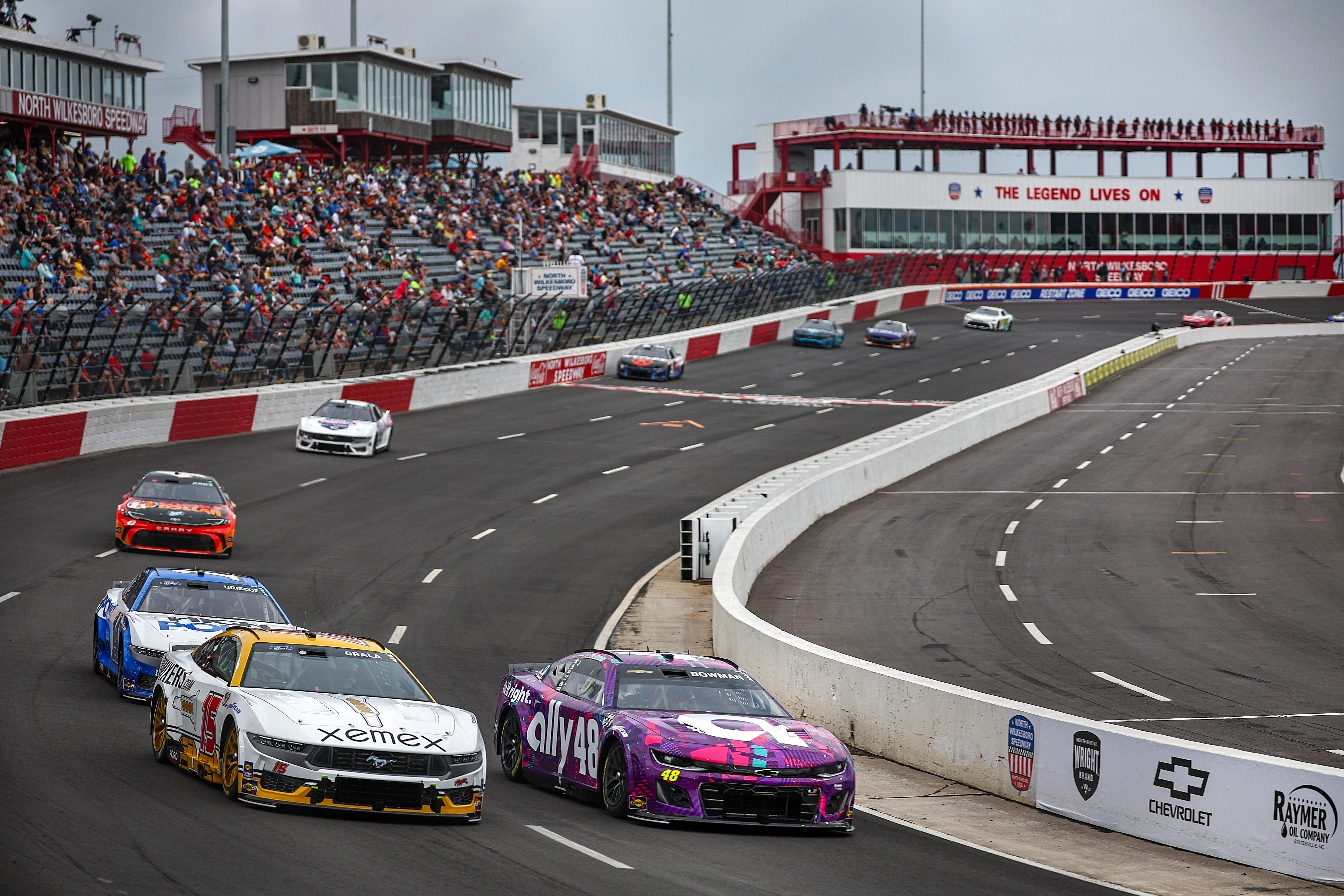Friday afternoon provided a data point but no one knows for sure how the option tire experiment for the NASCAR All-Star Race at North Wilkesboro will go until the checkered flag.
With that said, it was a data point that generally seemed to produce enthusiasm.
“They nailed it with this one,” said Denny Hamlin of Goodyear after the one-hour practice session. “It’s a great tire, great lap time variation between the two tires, and also the ability to pass with it, the difference of speed between the cars.
“We were searching for new pavement to try to get grip because the (cars) don’t want to be in the rubber because it’s kind of slick. But that was really, really fun. That was like back in the old short track days.”
Okay, that is encouraging.
Backtracking, there are numerous reasons NASCAR and Goodyear have ordered this experiment for the non-points exhibition. For one, North Wilkesboro received a repave over the winter and fresh pavement inhibits passing because it has so much grip that there is only one groove around the bottom.
But also, the current generation Cup Series car has done no favors to short track race quality over the past 30 months and NASCAR hopes that a tire that produces a tremendous amount of grip degradation is a potential solution.
So, if this weekend is deemed a success, either the high degradation tire compound or having multiple compounds for one race to create speed disparity might be the answer to fixing short track racing at the highest level.
During practice, teams were on different sets at different times, and it created immediate speed disparity. The option tire, with the red sidewall, was almost a half second faster that the primary yellow sidewall compound. There were multiple grooves and a ton of passing.
Martin Truex Jr. hit the key notes:
“It’s considerably faster, a couple of tenths, but it falls off faster too. We’re going to have to be strategic in how we use it.”
Hamlin expects a lot of movement throughout the field on Sunday night.
“There’s going to be a lot of shake ups through the field because of this,” Hamlin said. “If nothing else, we just had a fabulous practice session that looked like a great race out there.”
William Bryon is intrigued but hasn’t seen enough to know for sure how this is going to play out on Sunday.
“To me, just my personal experience, it had a couple of tenths more on the short run but then we faded back to the standard tire,” Byron said. “If you need to go on a late restart, that’s the tire you’re going to want but I think we still need to learn more about balance and setup because it was different when you changed from one compound to the other.”
Byron said the option tire gradually slowed down when it got hot but that it would gain speed again after it cooled down but would lose pace again on a run of several laps.
“That was weird, right,” Byron said rhetorically.
This was the forecast entering the weekend though, with crew chiefs predicting that the setup sensitivities of this car, meaning that teams would have to pick setting up for one tire over the other because a middle ground set-up would not likely produce merit.
Ross Chastain said his car was better balanced on the option tire.
“For me, we got our balance better for the reds because on the yellow, I was just sliding around a lot more,” Chastain said.
Another variable is the repave itself with drivers being generally complimentary of how the track took rubber, widened out and retained a lot of its underlying bumps and characteristics.
“There’s a really big bump off (Turn) 4, that you can kind of get into trouble hitting, some rough patches there, kind of wavy,” Blaney said. “But that was the fastest that a repave has rubbered in. The guys that tested here said they weren’t sure you could get two inches out of the groove without wrecking.
“I was curious about that. Did the option tire help it rubber in? Did the Late Models help it rubber in? We rubbered the second lane in 3 and 4 because no one else was running up there before us. It happened when we put the reds on it.
“That’s a positive thing. Be it the tire, the surface, a mixture of both, I don’t know but it was definitely a good surprise for a repave.”
Ultimately, this practice session was just one data point and now all the crew chiefs are going to get to work with their engineers and figure out a way to make the option tire fall off less without giving up speed.
That could present problems.
“The first crack at it was like, ‘okay, that’s alright’ but then we get to work on it and it doesn’t fall off at all,” Truex said. “We’ll have to wait and see. There’s a lot going on. The track is taking rubber too. A lot to think about.”
And Tyler Reddick says everyone making the prime tire last longer and fall off less has consequences for the racing peoduct as well.
“It’s kind of a double-edged sword,” Reddick said. “More grip is a good thing but that also means we’re closer to wide open, and a place like that, that hurts racing at the same time. Fall off is what’s good and it sounds like this tire does have more of it so far.”
Matt Weaver is a Motorsports Insider for Sportsnaut. Follow him on Twitter.

